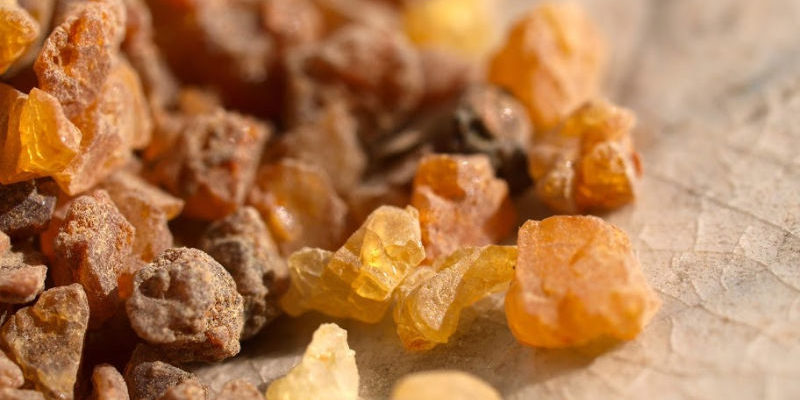If you’re looking to try something new and different for your health, try chewing on some Frankincense resin instead of commercial gum. Pop a tear of Frankincense in your mouth and it soon becomes the consistency of chewing gum, with the aromatic, gently invigorating flavor of the ancient Frankincense herb, Boswellia spp. Unlike commercial chewing gum, Frankincense tears can be chewed for hours (maybe indefinitely? We haven’t tried.) and have been used for ages to promote sacred health when taken internally, externally, and when burned as an incense. So, what are some of the health benefits of Frankincense?
Frankincense freshens the mind, boosting cerebral circulation and promoting clear, balanced thinking. Chewing Frankincense will improve the strength and quality of the voice. It promotes truth-telling and speaking from the heart. Frankincense has a long history of use as a powerful antiseptic and will rejuvenate the oral cavity, leaving your gums, teeth, and throat fresh and clean after chewing. It can be incredibly healing for inflammatory and/or bacterial oral conditions such as mouth ulcers and gingivitis. Chewing Frankincense is stimulating and healing to the digestive processes as well. It clears stagnation and ushers out excess gas, relieving the pain of colic. Dipping the tears in honey can help allay the bitter taste of the resin.
Frankincense is often marketed by its botanical name “Boswellia” as a medicine for arthritis, rheumatism and joint pain. The resin can be taken internally or put into a salve for topical relief. It is a superb anti-inflammatory and circulatory stimulant. It is also balancing to the menstrual cycle and relieves painful cramping. Inhalation of the steam has been known to help break up congestion and fight off bronchial infections of various kinds. Topically, Frankincense is used as an eyewash and an ingredient in healing salves for wounds, bruises, abrasions, and for beautification of the skin.
Frankincense has been burned as an aromatherapeutic incense since time immemorial, and the fragrance it produces is truly magical. Its naturally antiseptic healing incense clears the air both physically and energetically, creating space for improved communication. Charred Frankincense remains are an ingredient in “kohl”, the black powder used for painting the eyes and eyelids in Egypt.
Frankincense’s history of use in the Middle East and Africa is long and sacred. It is native to the Somali coast and areas of the Arabian Peninsula and is obtained by making cuts into the tree bark and collecting the resin that seeps out. It takes anywhere from 2 weeks to 3 months for the resin to harden into the “tears” we can burn, eat, steep for tea, and…chew!








Great Post. Thanks for sharing this post. It was very useful and I enjoyed it reading.
is this also known as Loban?
Loban and Frankincense have similar properties, but they come from different trees. I believe Loban comes from trees with the genus Styrax.
Yes, loban is the arabic word for frankincense.
Yes that’s what my husband ( from Tunisia ) calls it
Dear all,
Do you sell this item on your site? Is it the same product you have on your site under the name Frankincense Resin
Yes, that’s the one! Frankincense resin
What is it called in hindi
The botanical name for Frankincense is Boswellia serrata. I believe in Hindi it is Salai.
Sorry, but this variant of frankincense is not serrata. Clearly labeled boswellia papyrifera.
The Indian Frankincense is serrata, the Sudanese is papyrifera. They are generally used interchangeably. There are some new studies being done on the unique chemical properties of the various sub-species of Boswellia, but I’m not familiar with the details.
Can you chew/eat any kind of frankincense?
We recommend chewing food grade Frankincense only 🙂
I would love to chew on that for a while. I got bad teeth from have heart burn for years in the past and teeth grinding in my sleep. Im just wandering, can i chew to much for to long. Or can i use it everyday like chewing gum ?
It is safe for everyday use. However, resins are difficult on the digestive system and can cause stomach upset if eaten too often, so you may want to spit out the gum when you’re finished.
Every time I try to chew the resin I’m just almost completely melts and a tiny bit of sticky gum is left that ends up sticking to my teeth and then on my toothbrush and then it’s ruined.
What am I doing wrong? How is it possible to chew it as gum without it melting away and sticking to everything ??
Thanks!!
Hi George, sorry you’re having problems!
It might help if you let the piece of resin soften in your mouth for a minute before starting to chew. I’ve found that it does tend to dissolve if I start chewing too quickly.
I hope this helps! If not, it might be the quality of resin that you’re using. If what you have keeps melting too quickly to chew, you might consider powdering it for a mouthwash or tincture and reap the oral health benefits that way!
Can the frankincense resin sold on this site be used for chewing? Can you chew any frankincense resin or is it certain kinds?
Yes! We carry food-grade Frankincense on our website: http://www.smileherb.biz/product-p/500.htm
We recommend using food grade Frankincense only.
i chew frankincense and my kids both wanna have what i have but i am nervous to give it to them is it safe?
Hi Misty, I would not give Frankincense to children under 12 years of age.
🙂
Best trees you can fine in Hawai !